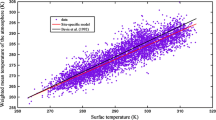Abstract
In studies of weather changes and, especially, in enhancing the performance of rainfall prediction, it is important to measure the water vapor distribution in the atmosphere. We estimated atmospheric water vapor profiles for fourteen days, including periods of severe weather conditions, by processing ground-based Global Positioning System (GPS) measurements and compared our results with microwave radiometer (MWR) and radiosonde (RAOB) observations. As a result, we found that the standard deviation (STD) of wet refractivity profiles between GPS with MWR was smaller than the STD between RAOB and MWR refractivities; the average STD was 9.3 mm km−1. In particular, we found that GPS-based wet refractivities detected inversion layers close to those from MWR when the observed GPS satellites were well distributed in the azimuth and elevation angle directions. When the satellite geometry was better, the mean error of GPS wet refractivities with respect to MWR was reduced to 0.4 from 3.2 mm km−1 for altitudes lower than 3 km. In some cases, however, the precision of GPS refractivities are lower than that of RAOB ones relative to MWR results.
Similar content being viewed by others
References
Baker, H. C., A. H. Dodson, N. T. Penna, M. Higgins, and D. Offiler, 2001: Ground-based GPS water vapour estimation: Potential for meteorological forecasting. J. Atmos. Sol.-Terr. Phys., 63, 1305–1314.
Bevis, M., S. Businger, T. A. Herring, C. Rocken, R. A. Anthes, and R. H. Ware, 1992: GPS meteorology: Remote sensing of atmospheric water vapor using Global Positioning System. J. Geophys. Res., 97, 11787–15801.
Davis, J. L., T. A. Herring, I. I. Shaprio, A. E. Rogers, and G. Elgered, 1985: Geodesy by radio interferometry: Effects of atmospheric modeling errors on estimates of baseline length. Radio Sci., 20, 1593–1607.
Flores, A., J. V. G. Arellano, L. Gardinarsky, and A. Rius, 2001: Tomography of the lower troposphere using a small dense network of GPS receivers. IEEE Trans. Geosci. Remote Sens., 39, 439–445.
Gutman, S. I., and S. G. Benjamin, 2001: The role of ground-based GPS meteorological observations in numerical weather prediction. GPS Solut., 4, 14–24.
Ha, J., K.-D. Park, K.-H. Chang, and H.-Y., Yang, 2007: Precision validation of GPS precipitable water vapor via comparison with MWR measurements. Atmosphere., 17, 291–298. (in Korean with English abstract)
Ha, S.-Y., Y.-H. Kuo, Y.-R. Guo, and G.-H. Lim, 2003: Variational assimilation of slant-path wet delay measurements from a hypothetical ground-based GPS network. Part I: Comparison with precipitable water assimilation. Mon. Wea. Rev., 131, 2635–2655.
Iwabuchi, T., I. Naito, and N. Mannoji, 2000: A comparison of Global Positioning System retrieved precipitable water vapor with the numerical weather prediction analysis data over the Japanese Islands. J. Geophys. Res., 105, 4573–4585.
Niell, A. E., 1996, Global mapping functions for the atmospheric delay at radio wavelengths. J. Geophys. Res., 101, 3227–3246.
____, Coster, F. S. Solheim, V. B. Mendes, P. C. Toor, R. B. Langley, and C. A. Upham, 2001: Comparison of Measurements of Atmospheric Wet Delay by Radiosonde, Water Vapor Radiometer, GPS, and VLBI. J. Atmos. Oceanic Technol., 18, 830–849.
Radiometrics corporation, cited 2007: MP-series microwave profiles. [Available online at http://www.radiometrics.com/MP_Specifications_7-3-07.pdf.]
Shrestha, S. M., 2003: Investigations into the estimation of tropospheric delay and wet refractivity using GPS measurements. M.S. Thesis, Department of Geomatics Engineering, University of Calgary, 142 pp.
Skone, S., and S. M. Shrestha, 2003: Strategies for 4-D regional modeling of water vapor using GPS. Proc. 2003 National Tech. Meeting of ION, Anaheim, CA, The Institute of Navigation, 809–816.
Troller, M., A. Geiger, E. Brockmann, J.-M. Bettems, B. Bürki, and H.-G. Kahle, 2006: Tomographic determination of the spatial distribution of water vapor using GPS observations. Adv. Space Res., 37, 2211–2217.
Webb, F. H., and J. F. Zumberge, 1993: An introduction to GIPSY/OASISII. JPL Tech. Rep. JPL-D-11088.
Author information
Authors and Affiliations
Corresponding author
Rights and permissions
About this article
Cite this article
Ha, J., Park, KD., Kim, K. et al. Comparison of atmospheric water vapor profiles obtained by GPS, MWR, and radiosonde. Asia-Pacific J Atmos Sci 46, 233–241 (2010). https://doi.org/10.1007/s13143-010-1012-1
Received:
Revised:
Accepted:
Published:
Issue Date:
DOI: https://doi.org/10.1007/s13143-010-1012-1




